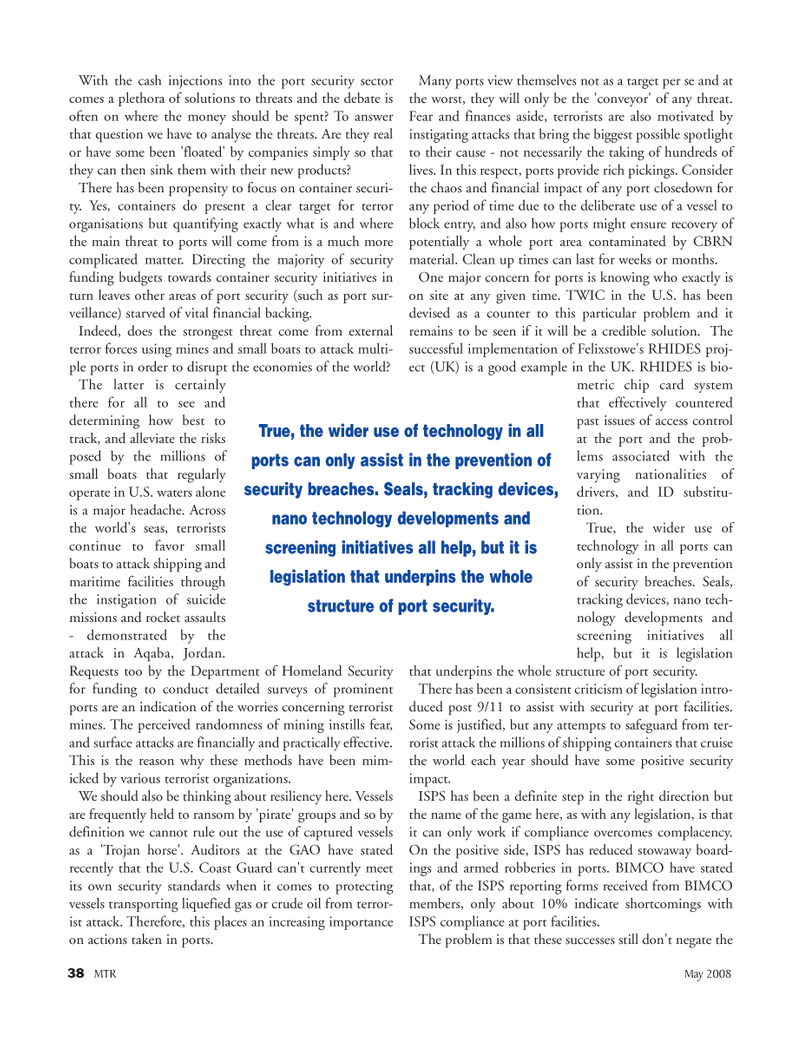
Page 38: of Marine Technology Magazine (May 2008)
Undersea Defense Edition
Read this page in Pdf, Flash or Html5 edition of May 2008 Marine Technology Magazine
38 MTR May 2008
With the cash injections into the port security sector comes a plethora of solutions to threats and the debate is often on where the money should be spent? To answer that question we have to analyse the threats. Are they real or have some been 'floated' by companies simply so that they can then sink them with their new products?
There has been propensity to focus on container securi- ty. Yes, containers do present a clear target for terror organisations but quantifying exactly what is and where the main threat to ports will come from is a much more complicated matter. Directing the majority of security funding budgets towards container security initiatives in turn leaves other areas of port security (such as port sur- veillance) starved of vital financial backing.
Indeed, does the strongest threat come from external terror forces using mines and small boats to attack multi- ple ports in order to disrupt the economies of the world?
The latter is certainly there for all to see and determining how best to track, and alleviate the risks posed by the millions of small boats that regularly operate in U.S. waters alone is a major headache. Across the world's seas, terrorists continue to favor small boats to attack shipping and maritime facilities through the instigation of suicide missions and rocket assaults - demonstrated by the attack in Aqaba, Jordan.
Requests too by the Department of Homeland Security for funding to conduct detailed surveys of prominent ports are an indication of the worries concerning terrorist mines. The perceived randomness of mining instills fear, and surface attacks are financially and practically effective.
This is the reason why these methods have been mim- icked by various terrorist organizations.
We should also be thinking about resiliency here. Vessels are frequently held to ransom by 'pirate' groups and so by definition we cannot rule out the use of captured vessels as a 'Trojan horse'. Auditors at the GAO have stated recently that the U.S. Coast Guard can't currently meet its own security standards when it comes to protecting vessels transporting liquefied gas or crude oil from terror- ist attack. Therefore, this places an increasing importance on actions taken in ports.
Many ports view themselves not as a target per se and at the worst, they will only be the 'conveyor' of any threat.
Fear and finances aside, terrorists are also motivated by instigating attacks that bring the biggest possible spotlight to their cause - not necessarily the taking of hundreds of lives. In this respect, ports provide rich pickings. Consider the chaos and financial impact of any port closedown for any period of time due to the deliberate use of a vessel to block entry, and also how ports might ensure recovery of potentially a whole port area contaminated by CBRN material. Clean up times can last for weeks or months.
One major concern for ports is knowing who exactly is on site at any given time. TWIC in the U.S. has been devised as a counter to this particular problem and it remains to be seen if it will be a credible solution. The successful implementation of Felixstowe's RHIDES proj- ect (UK) is a good example in the UK. RHIDES is bio- metric chip card system that effectively countered past issues of access control at the port and the prob- lems associated with the varying nationalities of drivers, and ID substitu- tion.
True, the wider use of technology in all ports can only assist in the prevention of security breaches. Seals, tracking devices, nano tech- nology developments and screening initiatives all help, but it is legislation that underpins the whole structure of port security.
There has been a consistent criticism of legislation intro- duced post 9/11 to assist with security at port facilities.
Some is justified, but any attempts to safeguard from ter- rorist attack the millions of shipping containers that cruise the world each year should have some positive security impact.
ISPS has been a definite step in the right direction but the name of the game here, as with any legislation, is that it can only work if compliance overcomes complacency.
On the positive side, ISPS has reduced stowaway board- ings and armed robberies in ports. BIMCO have stated that, of the ISPS reporting forms received from BIMCO members, only about 10% indicate shortcomings with
ISPS compliance at port facilities.
The problem is that these successes still don't negate the
True, the wider use of technology in all ports can only assist in the prevention of security breaches. Seals, tracking devices, nano technology developments and screening initiatives all help, but it is legislation that underpins the whole structure of port security.
MTR#4 (33-48).qxd 5/13/2008 10:24 AM Page 38

 37
37

 39
39
